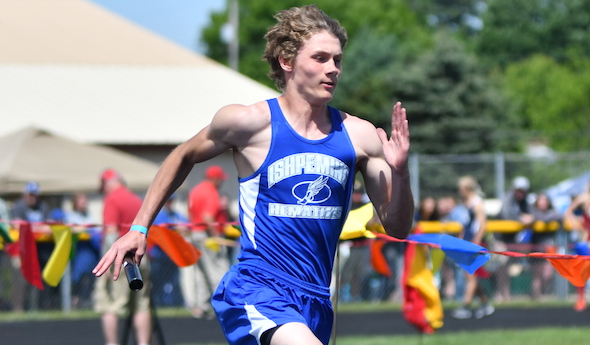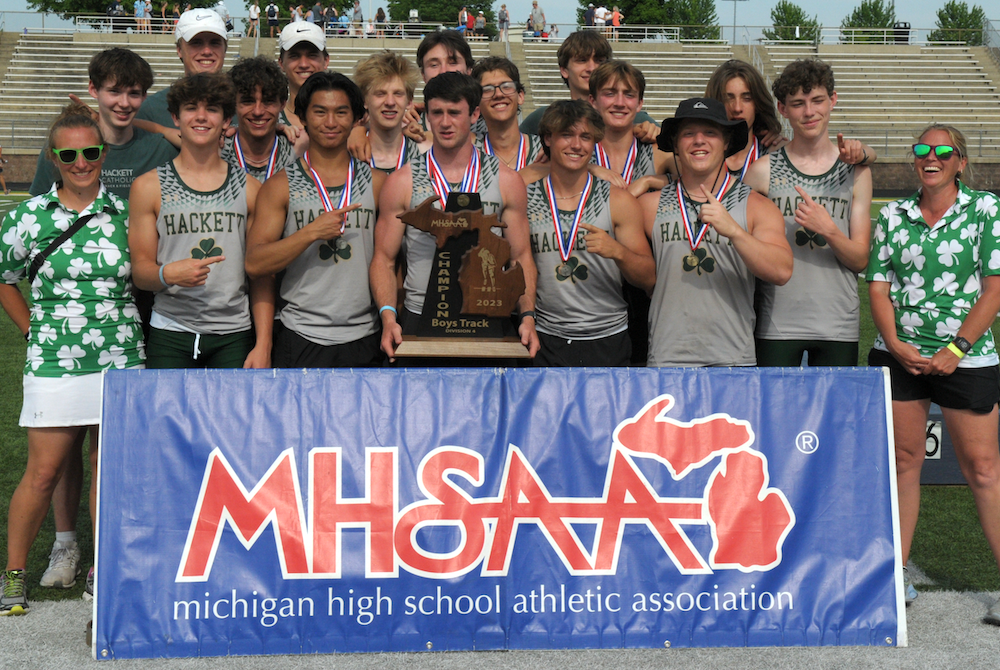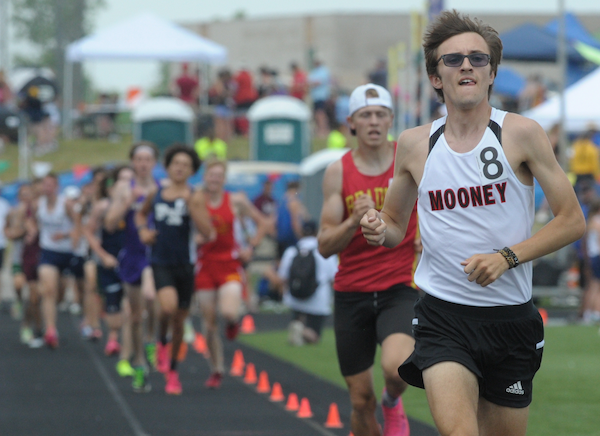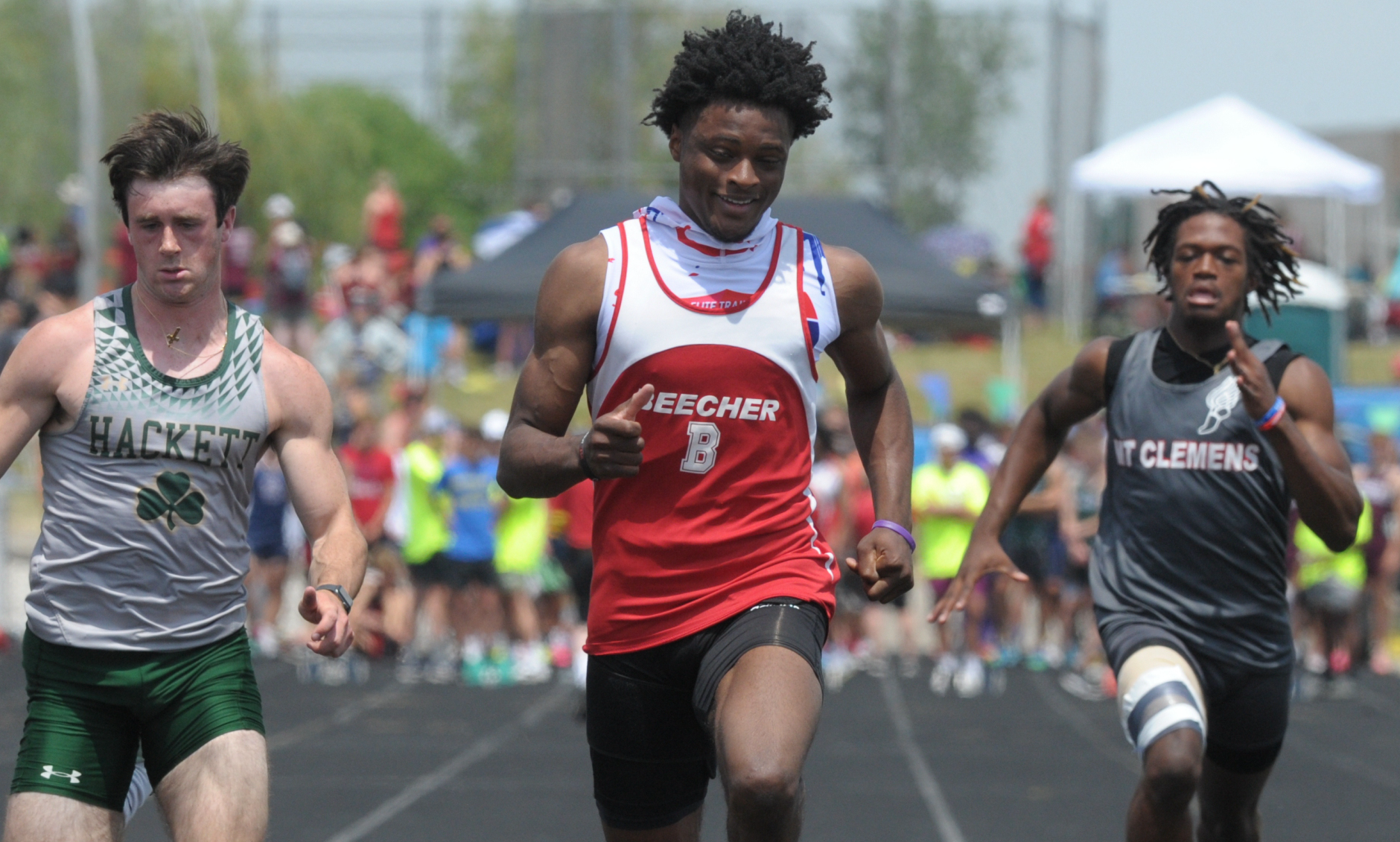
Ishpeming 'Grinds Out' 4th Title in 5 Seasons
By
John Vrancic
Special for MHSAA.com
June 3, 2018
KINGSFORD — First-place finishes may not have been plentiful for the Ishpeming boys Saturday, but they placed in enough events to edge Iron Mountain 90-82 for their fourth Upper Peninsula Division 2 track title in five years.
Third-place Norway scored 64 points, three more than reigning champ Newberry.
Hart Holmgren’s leap of 19 feet, 5½ inches provided Ishpeming with its lone first on this sunny, mild and breezy day at Flivver Field.
“I thought we’d win it by a little more, although it was still a good win,” said Ishpeming coach P.J. Pruett. “Our guys had to grind it out. I was very pleased with their fight to win. Our depth came through.”
The Hematites placed second in three relays and got runner-up finishes from Holmgren in high jump (6-2), Jonah Broberg in the 1,600 at 4 minutes, 48.24 seconds and Spencer Giroux in the 3,200 (10:38.83). They claimed three places in the 3,200 and two apiece in the 800 and 1,600.
“Distance is where we got our major points,” said Pruett. “That’s where we won the meet. Overall, we had a lot of third-place medal winners. Gavin Sundberg was seeded fifth in the 400 and placed third (53.01). Every point counts, and that was proven today. We put more than two in each (distance) event and that’s why we won.
 Beating Newberry in the Regional (May 18 at Manistique) was a big boost for us. Last year, we were runner-up in D-2 and Iron Mountain was runner-up in D-1. Surviving the Regional was key for us.”
Beating Newberry in the Regional (May 18 at Manistique) was a big boost for us. Last year, we were runner-up in D-2 and Iron Mountain was runner-up in D-1. Surviving the Regional was key for us.”
Iron Mountain’s Michael Kulas won the 800 (2:09.14), helped the winning 1,600 (3:40.31) and 3,200 (8:44.88) and placed second in the 400 (51.57). Junior Charlie Gerhard added a first in the 300 hurdles (41.1) and second in the 110s (16.55).
Norway senior Inocencio Stankevich won the 110s (16.0) and was runner-up in the 300s (41.93), and Josh Boulden provided a first in discus (131-3).
Newberry swept the sprint relays, edging Ishpeming on a lean for first in the 400 (45.35) and taking the 800 (1:34.05) in what is believed to be a school record.
“We fixed Brandon’s handoff,” said Newberry senior Andre James, who anchored both relays. “He (Christensen) dropped the baton in the (Straits Area) conference meet, but he did it perfect today. The 4x1 was really close and in the 4x2 we won by more than we thought. We just have some fast kids on the team and had a lot of adrenalin on a big stage. It’s exciting to be here. A lot of people turn out for this.”
Stephenson junior Montel Glover was a triple winner, taking the 100 (11.36), 200 (22.98) and 400 (51.3).
PHOTOS: (Top) Ishpeming Gavin Sundberg leads off the 800-meter relay. (Middle) Stephenson's Montell Glover, left, outleans Iron Mountain's Michael Kulas in the 400. (Photos by Cara Kamps. Click for more at RunMichigan.com.)

Thrower Claims Lone Individual Title to Lead Hackett to Team 3-Peat
By
Tom Lang
Special for MHSAA.com
June 3, 2023
Kalamazoo Hackett Catholic Prep just keeps winning and winning.
This time the Irish took home their fourth title in the last five Lower Peninsula Division 4 Track & Field Finals, on Saturday at Hudsonville.
Hackett’s only individual title was taken by discus winner Nathan Buchmann, a senior, who was fine knowing he was the shortest in stature among all the sizable competitors.
“In the offseason after football I worked out every day, working towards this goal,” he said after getting his medal. “I would say this takes 80 percent technique and 20 percent strength to throw the discus. So, length can help but if you have good technique and are really strong, that will play into it.
“I think we are very balanced throughout the meet today,” he said about teammates that scored points in finishes other than first place. “We have 13 guys here today, and we have people in a lot of the races. But I do not run; I have too short of legs to be a fast runner,” he said with a chuckle.
Buchmann had to work through a hip injury to compete this spring.
“I think the setbacks are what make you strong,” he said. “You can either give up through the setbacks or push forward and become better.”
 Coach Charissa Dean agreed.
Coach Charissa Dean agreed.
“The kids have big hearts,” she said after all the points were totaled and the Irish were on top once again, with 53. “They worked hard. They had a lot of potential when we started the season. And we had a lot of drive to put in the work, and we are happy the results came out the way they did.”
Reading was runner-up at 47 points, followed by Wyoming Potter’s House Christian with 42, then Fowler and Flint Beecher each with 37 points.
Senior Lezawe “Moses” Osterink, of Potter’s House Christian, placed second in 1,600 but took the 3,200 title as defending champ of both. He dominated the latter by lapping the field with a final lap kick that resembled more of a superhero speedster.
“Nobody really took it out that hard at the start,” he said. “There was a freshman (Marek Butkiewicz of Hackett) that tried to get the pace going quick, but me and Dakota (Dykhuis of Montabella) just kind of sat back and gradually pulled him through.
“We took it gradually, and I was just relying that I could kick.”
Kick did he ever. The trio were neck and neck the majority of the race in a grouping ahead of the pack.
“With 400 to go I just tried to go all out,” Osterink said. “I had a lot more left than I thought and I was pleased with the win. Not really the time, but that doesn’t matter, especially this hot out.”
The overall meet was in the low 90s/high 80s heat and searing sun all day. So, race officials allowed the unique opportunity for coaches to spray the runners with water and give them water bottles.
“It was very weird because I’ve never taken water to drink while I’m running, so I didn’t know how that would feel,” Osterink said. “And they were spraying us and hitting us in the face. It was kind of fun.”
Junior Tyler Lenn of Marine City Cardinal Mooney defeated Osterink at his own game in the 1,600.
“I’m feeling great,” Lenn said after grabbing the medal. “I said to a newspaper after one of my races (during the season) I was right where I wanted to be. This has been a long rebuilding process for me since an injury back in the fall, and I set a pretty high goal the day the injury happened. I was telling myself I needed to fulfill what I said I would do at the beginning of last cross country season. And that is what I did today.”
Lenn suffered an ankle sprain from a misstep that turned worse because he kept running through the season on it.
“Coming back from that was pretty tough, but I wouldn’t have it any other way,” he said.  “Perseverance; I said from the beginning what I was going to do. I kept my eye on that target, and no matter the circumstances life threw at me, that I was going to make it happen and I am a man of my word.”
“Perseverance; I said from the beginning what I was going to do. I kept my eye on that target, and no matter the circumstances life threw at me, that I was going to make it happen and I am a man of my word.”
Jaylin Townsend, a senior from Flint Beecher, dominated the short races. He won the 100 dash (10.67) and 200 dash at 22 seconds flat. It was his third 100 win at a Finals.
“I put in a lot of work; I had to three-peat,” he said after the 100. “There’s a lot of great competition here, so I knew I had to come out and run my best.”
Concord in the 400 (43.72), Buckley in the 800 (1:30.76) and 1,600 (3:29.13) and Potter’s House in the 3,200 (8:14.18) were relay champs Saturday. Reading’s Tayshawn Bester won the 110 hurdles (15.13), and Athens’ Landen Bennett won the 300 (39.85). Caseville’s Nathan Feltner won the 400 (50.76), and Vestaburg’s Owen Patton claimed the 800 (1:55.11).
Fruitport Calvary Christian’s Bradley Richards won the high jump (6-10), and Peck’s Alex Affer won the long jump (23-4). McBain Northern Michigan Christian’s Isaac Bowden was first in pole vault (13-0), and Brown City’s Kyle Affer won shot put (49-2).
PHOTOS (Top) Kalamazoo Hackett Catholic Prep celebrates its third-straight LPD4 title Saturday. (Middle) Cardinal Mooney's Tyler Lenn, far right, sets the pace in the 1,600. (Below) Flint Beecher's Jaylin Townsend, middle, crosses the finish first for one of his two sprint championships. (Photos by Ken Swart/RunMichigan.com.)

